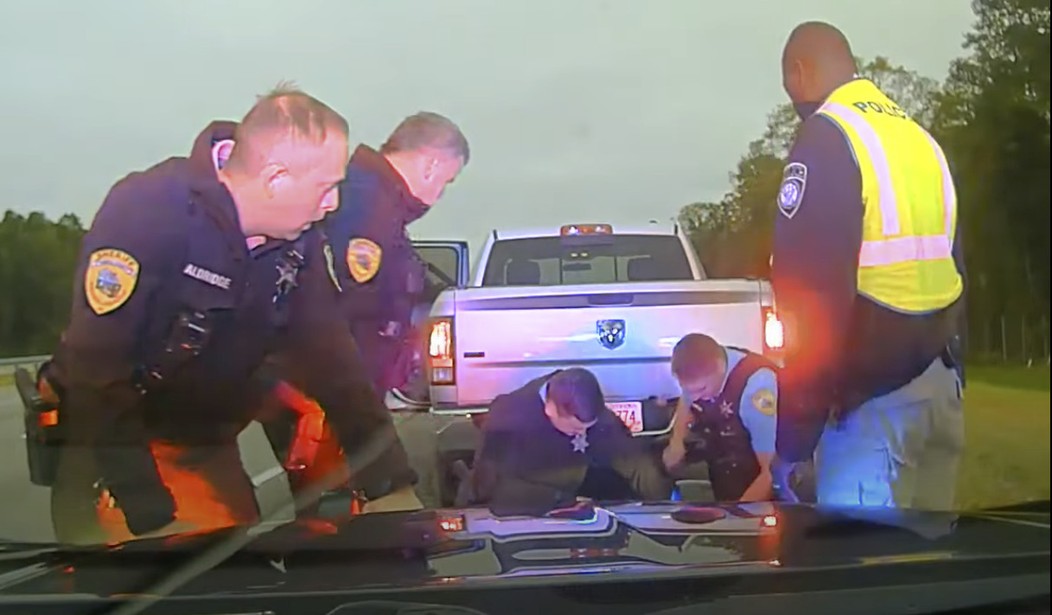On Thursday, I provided dashcam footage analysis of the Leonard Cure traffic stop that ended with a white cop shooting a black man. Mad love to everyone who took the time to comment, no matter what your position. The time has come, however, for a follow-up piece because the New York Post revealed that Buck Aldridge, the Camden County, Ga., Sheriff’s Staff Sergeant who shot Cure was previously fired from another Georgia police department for excessive use of force.
Aldridge joined the Kingsland Police Department in 2012, was told he needed to calm down at his annual review in 2013, and was issued a formal warning in 2014. He completed 618 hours of training in the five years he was with the department before he was fired for excessive force; Georgia peace officers are only required to receive 20 annually. Training topics must include de-escalation, use of deadly force, and community policing, which is a succinct way of saying, “be a part of the community you protect.”
Forty hours a week for 50 weeks a year is 2,000 hours. If the report is true, Aldridge spent 6% of his full-time job in training, and it shows.
Police utility belts hold:
- Keys (in a pouch)
- Handcuffs — tried to use them but the subject resisted
- A taser — used it
- A baton — used it
- A flashlight — if the baton didn’t work, maybe the flashlight would have?
- Pistol (in a holster) — used it
- Spare magazines (in a pouch) — unnecessary because only one round was fired.
Staff Sergeant Aldridge not only used every relevant item in his belt (as well as the radio on his shoulder) before he even reached for his pistol, but even then, he was being choked by a subject aware of the inflicted suffering. What else could “Yeah, b*tch. Yeah, b*tch.” mean?
Here is one of the primary lessons Aldridge, and all cops for that matter, learned in training:
Five Points of Threat Recognition
- General Impression and Whole Body Survey
Any reasonable person would get the general impression that Cure was not interested in staying out of trouble when he failed to immediately pull over. Cure argued the entire first half of the incident, and despite the high levels of stress, Aldridge explained why Cure was pulled over, why he was under arrest, who he (Aldridge) was, and what authority he had. But Aldridge was shouting! Okay, you go stand next to a major interstate 14 inches from the shoulder with cars and trucks zooming by and try to have a conversation from a distance without shouting. - Hands
Cure stood with his hands at his sides during the initial altercation. Aldridge did not consider the man’s hands to pose a threat, although he did wish to detain Cure, but we’ll get to that in Number 5. - Waistband
When Cure had his hands on the truck, Aldridge took a moment to walk behind him and lay eyes on the lack of his waistband. The officer had seen the front and, after seeing the back, determined there was not a weapon in the waistband. - Lunging and Reaching Distance
You’ll notice that Aldridge steps back from Cure while drawing his taser and maintains a distance far enough to prevent Cure from lunging at or reaching for Aldridge. - Compliance and Demeanor
This is where things get particularly incriminating for Cure. Instead of complying, he ran his mouth. His demeanor was defiant, disrespectful, and challenging. While I understand how Cure could not and would not trust the justice system after his wrongful incarceration, it is far better to be judged by 12 than carried by six. Readers, if y’all take nothing from this, when dealing with any armed person, whether they wear a badge or not, comply now and fight later. Survive. That’s all you have to do in that moment.
Cure’s mother can blame Georgia all she wants, and his brother can paint the state as a bastion of racism and hatred, but this is not what happened here. When Aldridge saw a silver pickup speeding in the far left lane, he did not know who was driving that vehicle. Despite popular belief, officers cannot call in a plate and get biodata back on the owner (not the driver) immediately. Aldridge had no way of knowing the driver of the vehicle was black or an exonerated man.
Related: Dashcam Footage Analysis: Why ‘Justice for Leonard’ Will Fail
But the cop was screaming! He should have de-escalated the situation! Maybe. Consider the biochemical changes stress puts on a body. During life-or-death encounters, research shows that people can experience auditory exclusion, meaning they don’t hear as well. Moreover, go stand 14 inches from a major interstate with vehicles and semis zooming by and tell me how easy it is to have a conversation without shouting while maintaining a one-car-length distance between you and the other party.
As far as the PTSD defense goes, we now also know that Cure did not seek help for his mental health afflictions caused by his wrongful incarceration. Cure’s mother stated that her son did not want to be seen as “weak” for getting help for his trauma.
This is the part of the story where I will get on a soapbox:
I have experienced significant and prolonged trauma, and I have received more help than anyone knows in overcoming it. Trauma physically changes your brain. The actual structure and brain chemistry changes. There is nothing you can do to change it back. Trauma is not your fault, so the changes in your brain are not your fault.
Getting professional help to address the science of trauma is not a sign of weakness.
Enduring everything from exposure therapy to cognitive behavioral therapy, EMDR to pharmaceuticals, whatever it takes to allow a victim of trauma to overcome it is what we as friends, family, and a whole society need to do.
If we keep stigmatizing mental health care treatments, we end up with a Leonard Cure situation.
Staff Sergeant Aldridge will come out of this encounter without a criminal conviction, even if he is charged. To register training hours, your instructor has to sign off on the test you have to pass. Video footage and the Brinks eyewitness are credible evidence. I understand the family is distraught. I know racial tensions are still high in America. I know things are hard and we just want someone to take the blame. Sometimes, though, the only one who can take responsibility is the one who died from a single gunshot wound on the side of a highway after trying to strangle a cop.
By the way, if anyone can find the 2017 footage of Aldridge’s excessive force, please send it to us. I can look at it and show you further effects of training, as well as what is just part of Aldridge’s DNA.
As always, many, MANY thanks to our readers for taking the time to comment. I truly enjoy the discourse and insight y’all provide, especially when it’s to correct a math error. Aldridge was reported to have trained 618 hours over five years, which would amount to 6% of his time training, still six times more than the requirement.
PJ Media readers should know that I am never afraid to admit when I have made a mistake and, especially in the case of math, it’s going to happen.










Join the conversation as a VIP Member